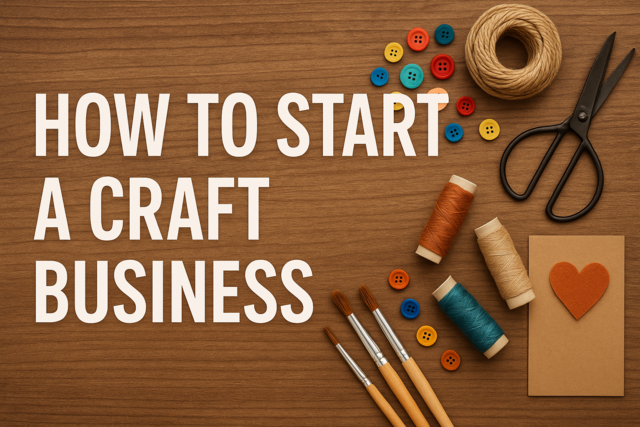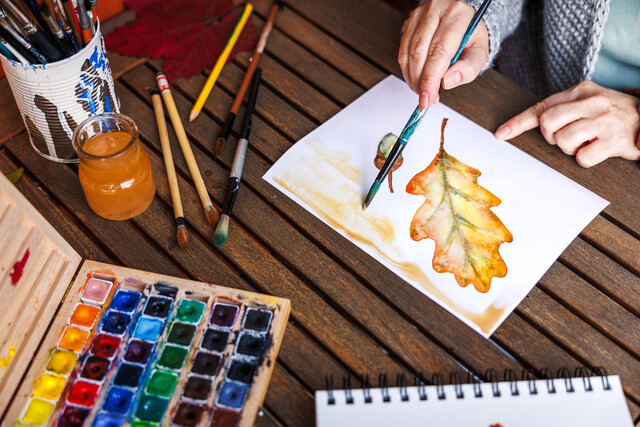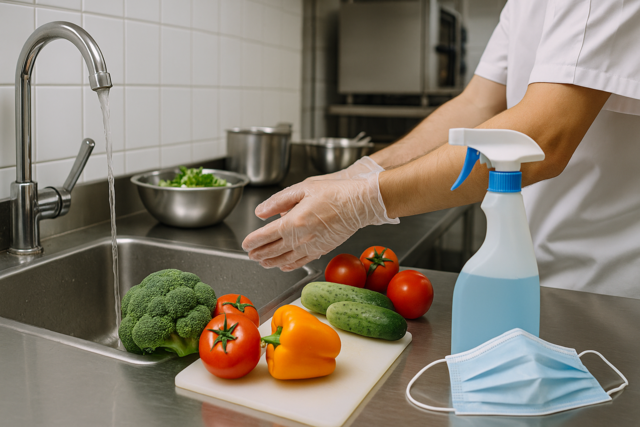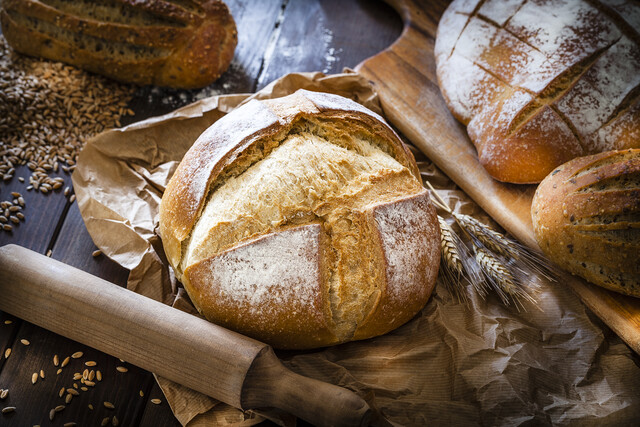The basis of most cookie recipes is a mixture of flour, sugar, eggs, butter, baking soda, and salt. Everything else enhances the flavor and differentiates between one delectable batch and another. When baking a batch of cookies, every ingredient is important. You must always be aware of the quality of each ingredient and how it will affect your recipe.
Flour:
Always use the type of flour that the recipe calls for. Every type of flour behaves differently when combined with different ingredients and under different circumstances. Do not pack the flour into the measuring cup. Spoon the flour into the cup and scrape the top with a butter knife or spatula to level the flour. If you use the cup as a scoop it will pack the flour causing you to use more flour than the recipe intended. Too much flour creates hard, dense cookies.
Sugar:
Again, like flour, use the sugar that is called for. Sugar is a tenderizer and is a determining factor in the way your cookies spread. Finer grinds melt more quickly and cause cookies to spread faster.
Eggs:
Always use fresh eggs. Look at the expiration date before each use. If the recipe calls for large eggs, do not use small eggs. The difference in size will disrupt the balance between dry ingredients and wet ingredients. Generally, it is a good idea to place the eggs that you will use in your recipe in a bowl on the counter an hour or two before use so they reach room temperature. Not as much air will be allowed into the mixture if you beat cold eggs.
Butter:
Use unsalted or salted depending on the recipe instructions. If it does not specify, use unsalted butter, but do not remove any of the extra salt from the recipe. Never place your butter in the microwave as it will heat unevenly and will, most likely, melt more than desired. If you do not have an hour lead time to place butter on the counter, then cut it into small cubes or use a cheese grated to grate it into small pieces before allowing it to sit on the counter to warm. Most recipes will specify the texture and warmth of the butter desired.
Room Temperature Butter � This butter will leave a finger indentation when pressed. It is pliable but easily picked up and moved. Allow cold butter to sit out of the refrigerator for at least one hour to achieve this butter texture and temperature.
Softened Butter � This type of butter is softer than room temperature butter: more slick and greasy. You will still be able to move it with your hands.
Soft Butter �This type is too soft to move with your hands, but it will not be fully melted.
Melted Butter � Fully melted butter (in liquid state) is relatively rare for cookie baking. In order to achieve fully melted butter, it is fine to use the microwave or sauce pan.
Baking Soda or Baking Powder:
Always make sure these ingredients are fresh! If they are not, then your cookies will be hard and dense. When working at higher altitudes, you can opt to omit the baking soda altogether because the lower pressure increases cookie spreading on its own. Too much baking soda will cause over-browning and too much spread. Baking soda is usually only good for about a month after opening. You can test the freshness of both baking soda and baking powder rather easily.
-
Baking Soda � Fresh baking soda will bubble when added to vinegar.
-
Baking Powder � Fresh baking powder will bubble when added to hot water.
Salt:
Never remove the salt from the recipe. The salt helps to bring out the other flavors in the recipe and works with the baking soda for proper rise. If you are using unsalted butter, use the full amount of salt the recipe calls for. When using salted butter, you can use � the salt the recipe calls for if you so choose.
Other Ingredients:
After you have mastered the basic ingredients, those mentioned above, you can begin to look at other ingredients that make cookies special. These include but are not limited to dried fruit, nuts, spices, extracts, and chocolate.
Dried Fruit:
The most common of these are raisins. Raisins come in the standard brown variety (purple grapes) and a lighter golden type (green grapes). Both add a sweet, natural flavor to the cookie but the golden raisins are milder and tend to be less bothersome to people who are generally not fans of dark raisins. Other dried fruits used for cookies are cranberries, blueberries, and cherries. These are generally sweetened but not always. Be aware of the variety that you are buying, whether you are going for sweet additions or tart ones. Tart dried cherries, for instance, are delicious paired with cocoa powder and dark chocolate chunks.
Nuts:
Nuts are a very common addition to all different kinds of cookies. They can add a delicious, rich crunch but you must be sure they are fresh. Nuts go rancid rather quickly and when they do, they have an awful taste. Rancid nuts will ruin a batch of cookies in a heartbeat. Always taste your nuts before using them in a recipe, no matter how long ago you bought them.
Spices:
Cinnamon, allspice, nutmeg, and ginger. These are some of the most common spices used in cookie baking. Spices are used in small quantities, but they pack a big punch.
Extracts:
Vanilla extract, the most common baking extract, is used in almost all cookie varieties due to its warm, gentle flavor. The mixture of sugar, butter, and vanilla could be called the trifecta of baking. Vanilla can be rather expensive, so the imitation vanilla extract is sometimes tempting. Always buy the pure vanilla extract. A little bit will go a long way and pure extract is much stronger, richer, and more flavorful that its imposter. There is no comparison between the two.
Chocolate:
Chocolate has so many varieties and complexities that it will be discussed in length in the following chapter.
Conclusion:
If you can afford the organic, local variety then go with it. This is especially true with eggs, butter, and nuts. Local and organic choices are generally fresher; therefore, they improve the overall flavor of the cookie.
Glazes and Frostings
Glazes and frostings can turn a simple cookie into a festive treat. Frosting can be thick enough to make your cookies look like little cakes or it can be used to fill a sandwich cookie. A glaze is thinner but no less merry and inviting. You can use any frosting recipe you would like to top your cookies but there are a few great recipes that work every time.
Glazes:
Glazes are generally much thinner than frostings. When a glaze sets that means that is given time to cool at room temperature and harden to its completed state. Most glazes are smooth and hard when cool. A glaze that has set should have a slightly shiny hue, hence the name "glaze."
For Dipped Cookies: Dip completely cooled cookies into your glaze and lay on a wire rack or a sheet of parchment paper to cool.
For Iced Cookies: Wait until the glaze cools for about 10 - 15 minutes. It should still be warm and pliable, but not too runny. With a spatula spread the icing on each completely cooled cookie, or fill a piping tube with the glaze and apply to the cookie. Lay on a sheet of parchment paper or a wire cooling rack while the glaze sets.
Simple Vanilla Glaze:
Ingredients
-
3 � 3 � cups powdered sugar
-
�?? cup milk
-
1 teaspoon vanilla extract
-
2 tablespoons butter
-
� teaspoon salt
Directions
1. Melt the butter in a small saucepan over a medium heat (do not allow to boil).
2. Add milk to the saucepan and stir.
3. Remove the saucepan from heat.
4. Add vanilla and salt.
5. Add sugar slowly while stirring until you reach your desired consistency.
Optional additions and substitutions
1 teaspoon food coloring instead of vanilla � This is great when decorating cookies with the kids. You can put different colors in different icing tubes and let the children decorate their own cookies.
� teaspoon cinnamon � This will make a beautiful cinnamon vanilla glaze which is great for sugar cookies, spice cookies, or pumpkin cookies.
1 teaspoon cornstarch � This will allow your glaze to set up nice and thick. Remember: the thicker the glaze, the sweeter the bite. You may want to use � cup less sugar if you add cornstarch.
Chocolate Glazes:
A good chocolate glaze can go with just about any cookie. There are two ways to make a chocolate glaze. The first would be to use the recipe for a simple vanilla glaze and add 2 tablespoons of cocoa powder to the mix. This will create a glaze that is light and chocolaty. The second is much richer and its recipe is as follows.
Decedent Chocolate Glaze:
Ingredients
-
1 cup heavy cream
-
8 ounces coarsely chopped semisweet chocolate (or semisweet chocolate chips)
Directions
1. Place chocolate in a mixing bowl and set aside.
2. Bring cream to a boil in a medium saucepan.
3. Pour cream over the chocolate and whisk until smooth. Do not use an electric mixer.
Frostings:
Frostings are thicker than glazes, and are great beds for decorations such as sprinkles. They are also the best fillers for sandwich cookies due to their thickness, as opposed to the shiny thinness of glazes.
Cream Cheese Frosting:
Ingredients
-
1/2 cup of butter at room temperature
-
8 ounces cream cheese at room temperature
-
2 - 3 cups of powdered sugar
1. With an electric hand mixer, blend the butter and cream cheese together until smooth. This should take 2 - 4 minutes on a medium speed. Pause a few times to scrape the sides and bottom of the bowl with a spatula to ensure all ingredients are fully mixed.
2. Add the vanilla and blend. Add powdered sugar slowly until you reach your desired consistency and sweetness.
3. Spread directly onto each completely cooled cookie and place on a sheet of parchment paper while the frosting sets.
Optional Additions
Just a half teaspoon to a full teaspoon of any of the following spices, teas, and herbs can have your guests asking your secret:
-
Chinese Five Spice makes for an exotic blend which pairs nicely with a chocolate cookie.
-
Freshly ground ginger adds depth to any spice cookie.
-
Chai spice and Earl Gray tea (the contents of one teabag) are additions you would rarely find even in bakeries. They add complexity and rich flavor to your icing.
-
Scrape the insides of a vanilla bean to add the classic look of expensive vanilla to your icing. The vanilla bean enhances the flavor and beauty of a red velvet cookie.
-
Shredded (unsweetened) coconut flakes go well with a chocolate coconut cookie.
Thick Vanilla Frosting:
Ingredients
-
2 cups powdered sugar
-
2 tablespoons butter, softened
-
2 tablespoons milk
-
� teaspoon vanilla extract
Directions
1. Put all ingredients in a large mixing bowl.
2. Using a hand mixer, whip ingredients until light and fluffy.
3. Using a spatula, spread onto each completely cooled cookie.
Thick Chocolate Frosting:
Ingredients
-
2 tablespoons cocoa powder
-
2 cups powdered sugar
-
2 tablespoons butter, softened
-
2 tablespoons milk
-
� teaspoon vanilla extract
Directions
1. Add all ingredients to a large mixing bowl.
2. Mix until light and fluffy.
3. Using a spatula, spread on each completely cooled cookie.
Optional Additions
Melt 4 ounces of semisweet chocolate in a double boiler (or a glass bowl on top of a pot with 1 � - 2 inches of water) and add to icing mixture. Wait until the melted chocolate has cooled slightly. It should be thick but pliable. You may also need to add more powdered sugar to the frosting mixture to ensure that the chocolate does not make the frosting too thin.
Conclusion:
An icing is only as good as the weather. Always take into consideration what type of event your cookies are for before considering a frosting or glaze. They do very well in any weather below 70� and out of the sun, but you may not want to bring chocolate dipped cookies to a picnic in 100� heat or you will have a muddy-looking mess on your hands. Glaze is pretty and shiny in cool weather, but runny and sticky in warm weather.

























